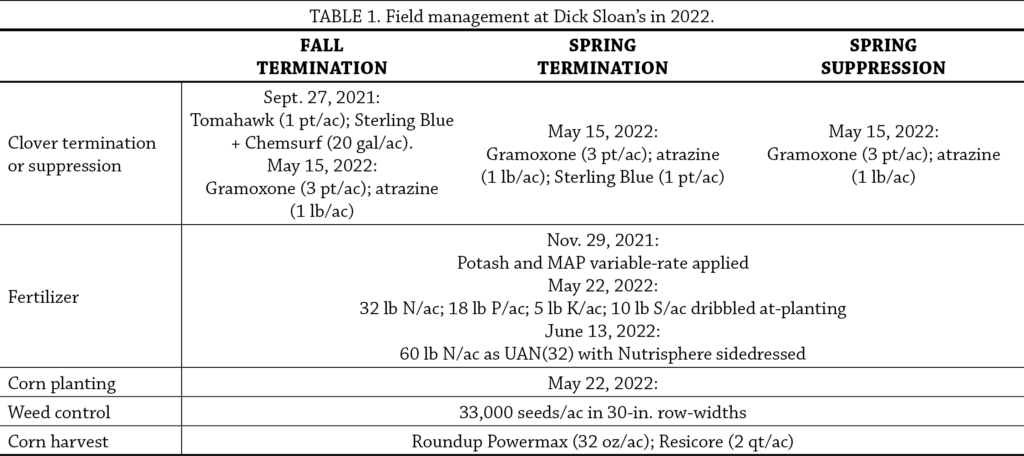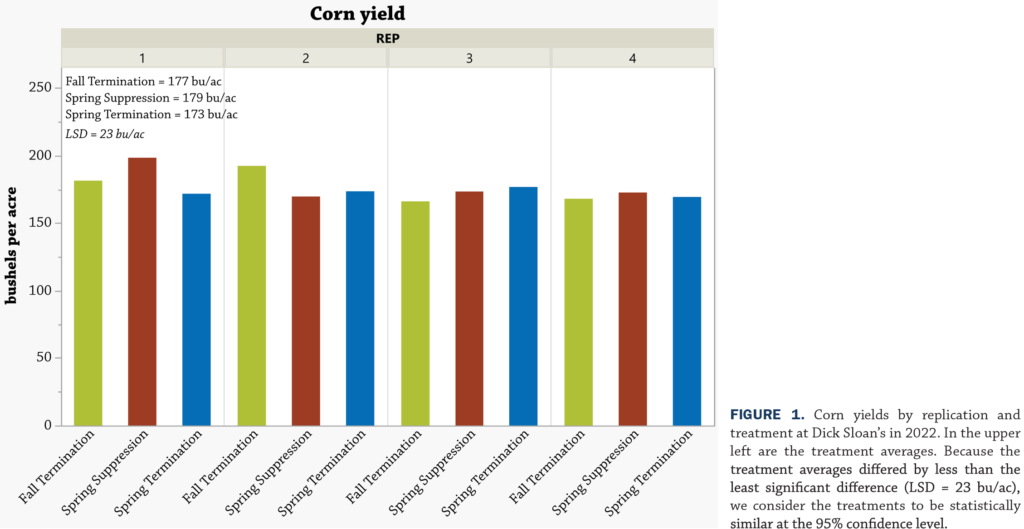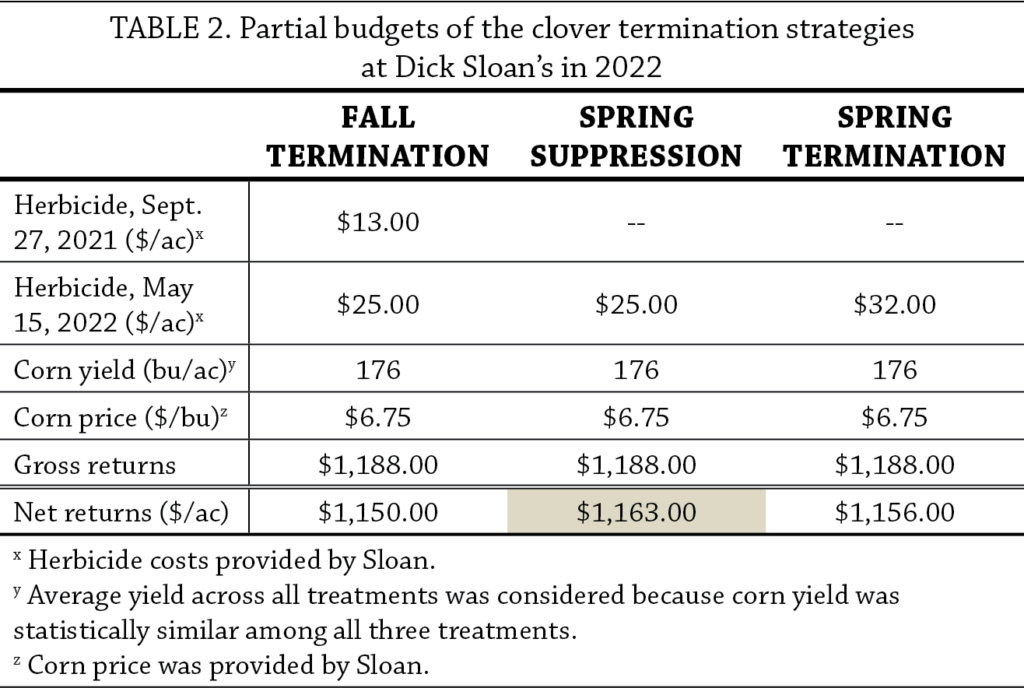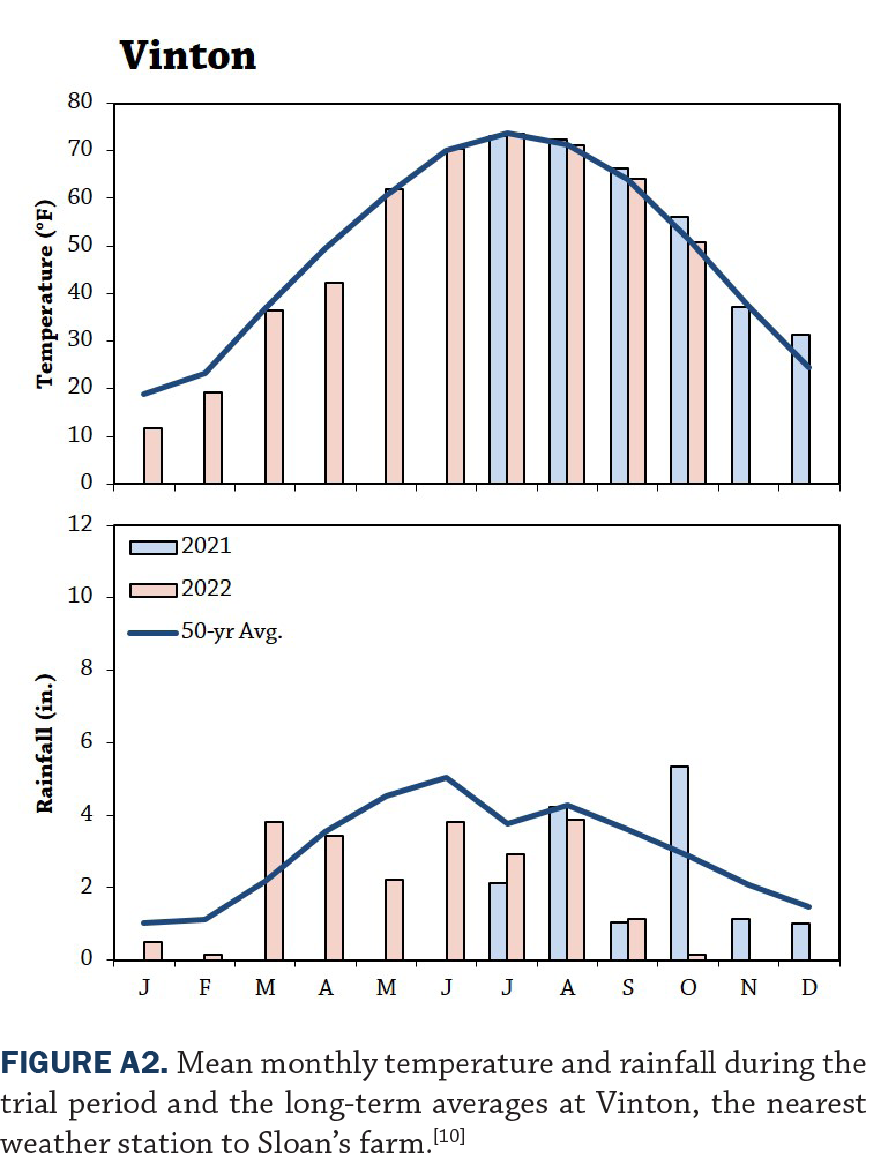This research was funded by the Walton Family Foundation.
In a Nutshell:
- Dick Sloan has experimented with clovers and other legume green manure cover crops over the past few years. In this trial he trained his focus on when to terminate a clover cover crop before a succeeding corn crop.
- Sloan compared the effects of three termination date strategies: fall termination, spring termination and spring suppression of a clover cover crop on corn yield and financial returns.
Key Findings:
- Corn yields were similar among all three clover termination strategies.
- Spring suppression (chemically) of the clover ended up terminating the clover by mid-June and also ended up the least expensive of the three strategies.
Background
Since expanding his corn-soybean crop rotation to include small grains over the past decade, Dick Sloan has conducted several experiments aimed at optimizing management of a nitrogen-fixing green manure cover crop between the small grain and corn phases.[1–5]
In 2020, Sloan compared yield and profitability of corn preceded by two different clover treatments – one in which a mix of medium red and alsike clover was interseeded to a cereal rye grain crop then terminated the subsequent spring, and another in which a mix of crimson and berseem clover was planted following cereal rye grain harvest and which winterkilled.[3]
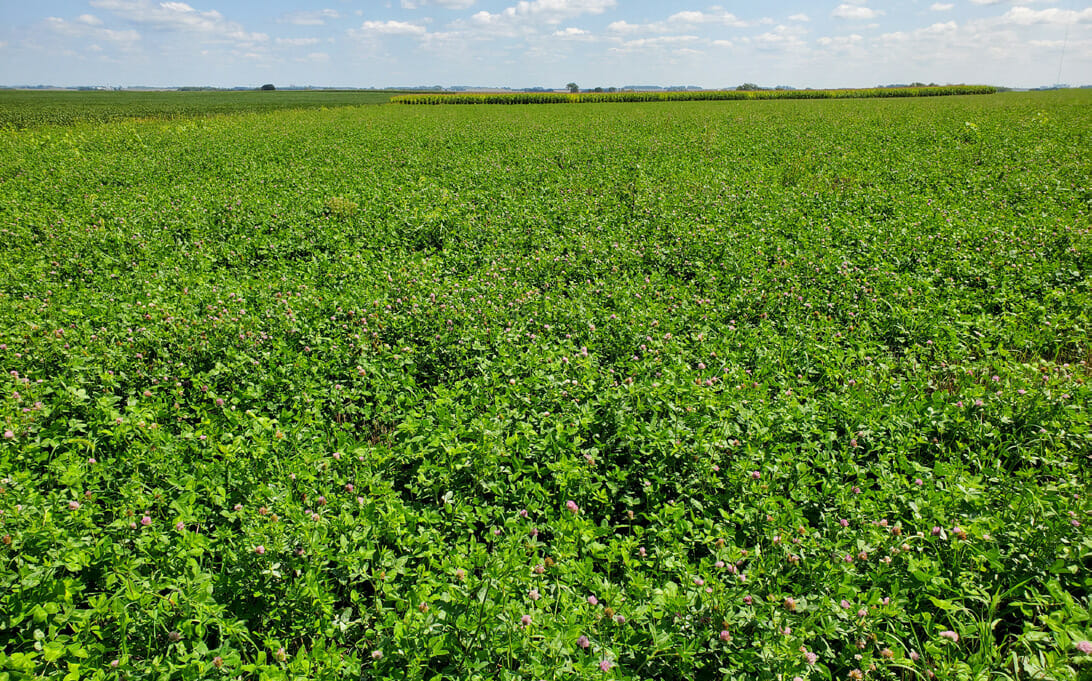
A lush, knee-high stand of red and alsike clover in bloom at Dick Sloan’s on Sept. 1, 2021. The clovers were interseeded on Apr. 5, 2021 to a rye crop that was harvested for seed on July 17, 2021.
While Sloan sees both mixes as suitable for different scenarios, the trial solidified his preference for interseeded red and alsike clovers. Sloan’s curiosity did not stop there, though. Knowing his preference for interseeding red and alsike clovers to small grains, he then became interested in fine-tuning nitrogen dynamics; specifically, how termination date of the clover green manure might affect nitrogen availability to a succeeding crop. Sloan commented, “By maximizing nitrogen availability from the clover cover crop, I will minimize my need for nitrogen in the corn year of my rotation.”
Sloan hypothesized that terminating clover in the fall will provide more nitrogen in the corn year and greater corn yield than terminating or suppressing the clovers in the spring. “Growing small grains is important to my farm operating plan,” Sloan said. “This project will help me decide among three methods for rotating a succeeding clover crop back to corn the following year.”
Methods
Design
On Apr. 5, 2021, Sloan interseeded medium red clover and alsike clover to an existing cereal rye crop. The rye was harvested on July 17, 2021 after which he compared three termination strategies for the clovers ahead of a corn crop in 2022:
- Fall termination – Clovers terminated in fall 2021 prior to freeze-up.
- Spring termination – Clovers terminated in spring 2022 before planting corn.
- Spring suppression – Clovers chemically suppressed in spring 2022 before planting corn and allowed to grow with corn.
Sloan replicated each treatment four times, for a total of 12 strips (Figure A1). Besides the termination strategy, the strips were treated identically (Table 1).
On June 18, 2022, Sloan noted that the clovers in the Spring suppression treatment were no longer alive; the chemical application on May 15 that was designed to suppress the clover ended up terminating it.
Measurements
Sloan collected cornstalk samples for nitrate-nitrogen assay from the Fall termination and Spring termination strips on Oct. 15, 2022 and sent them to Ag Source Laboratories (Lincoln, NE) for analysis. At harvest on Oct. 27, 2022, Sloan recorded grain yields and moisture from each individual strip. Reported yields are corrected to 15.5% moisture.
Data Analysis
To evaluate the effect of clover termination strategy on corn, we calculated Tukey’s least significant difference (LSD) at the 95% confidence level. If the difference between any two of the treatments was greater than the LSD, we would expect such a difference to occur 95 times out of 100 under the same conditions – we refer to this as a statistically significant effect. On the other hand, if the resulting difference between any two treatments was less than the LSD, we would consider the results to be statistically similar. We could make these statistical calculations because Sloan’s experimental design involved replication of the treatments (Figure A1).

Light green strips depict dying clover where Dick Sloan sprayed in the Fall termination treatment on Sept. 27, 2021. Photo taken Sept. 30, 2021.
Results and Discussion
Cornstalk nitrate
Stalk nitrate concentrations from the Fall termination (65 ppm) and Spring termination (69 ppm) were statistically similar (LSD=34 ppm). Both values would be considered ‘low’ by ISU standards (<250 ppm).[6]
Corn yield
Corn yield was not affected by clover termination strategy (Figure 1). As with previous academic research in Ontario[7] and Iowa,[8] corn yield at Sloan’s was similar where clover was terminated in the fall or spring. In early July, Sloan noted that the corn in the Fall termination strips did appear greener and taller than those in the other treatment strips. This visual observation, though, did not correspond with the cornstalk nitrate or yield results. Across all treatments, the average yield was 176 bu/ac which is below the five-year average for Buchanan County (209 bu/ac) where Sloan farms.[9]

At right, corn from the Fall termination treatment appeared greener and taller than corn in a neighboring strip from the Spring termination treatment. Photo taken July 4, 2022.
Economic considerations
The Spring suppression treatment provided top net returns among the three treatments (Table 2). This was because it was the least expensive of the three treatments and all three treatments resulted in statistically similar yields (Figure 1). The Fall termination treatment was the most expensive because along with the September 2021 herbicide application, it required another application in May 2022. Recall that the Spring suppression ended up terminating the clovers rather than allowing the clovers to grow with the corn. Thus, the Spring suppression treatment turned out to be a de facto, less expensive termination strategy than the Spring termination treatment ($25/ac vs. $32/ac).
Conclusions and Next Steps
“Though the treatments didn’t show a yield difference at the end, I gained several insights to the differences between Fall and Spring termination of clover after rye,” Sloan said of his results. He was intrigued by the Fall termination treatment because of the greener corn plants he observed in July and, looking forward, the opportunity for earlier corn planting that fall clover termination affords. “I can get a jump on spring planting of corn after clover with fall termination,” Sloan added. “[Also], I think I have good opportunities to minimize the cost of fall termination” (Table 2). He also mentioned that fall termination of a clover cover crop is “best suited for a farmer that does all of their own spraying with GPS guidance, who doesn’t mind getting spray equipment back out in September or early October.”
Appendix – Trial Design and Weather Conditions
References
- Gailans, S. and D. Sloan. 2015. Corn Following Green Manure Cover Crops Established with Small Grain. Practical Farmers of Iowa Cooperators’ Program. https://practicalfarmers.org/research/corn-following-green-manure-cover-crops-established-with-small-grain/ (accessed November 2022).
- Gailans, S. and W. Dooley. 2016. Effect on corn of green manure cover crops established with cereal rye seed crop. Practical Farmers of Iowa Cooperators’ Program. https://practicalfarmers.org/research/effect-on-corn-of-green-manure-cover-crops-established-with-cereal-rye-seed-crop/ (accessed November 2022).
- Nelson, H. and D. Sloan. 2021. Overwinter vs. Winterkill Clover Green Manures in a Rye Small Grain and Corn Rotation. Practical Farmers of Iowa Cooperators’ Program. https://practicalfarmers.org/research/overwinter-vs-winterkill-clover-green-manures-in-a-rye-small-grain-and-corn-rotation/ (accessed November 2022).
- Gailans, S., J. Boyer and D. Sloan. 2021. Allowing Established Clover to Grow with Corn. Practical Farmers of Iowa Cooperators’ Program. https://practicalfarmers. org/research/allowing-established-clover-to-grow-with-corn/ (accessed November 2022).
- Nelson, H. and D. Sloan. 2020. Green Manure Cover Crop Seeding and Termination Dates in Wheat-Corn Rotation. Practical Farmers of Iowa Cooperators’ Program. https://practicalfarmers.org/research/green-manure-cover-crop-seeding-and-termination-dates-in-wheat-corn-rotation/ (accessed November 2022).
- Sawyer, J. and A. Mallarino. 2018. Use of the End-of-Season Corn Stalk Nitrate Test in Iowa Corn Production. Iowa State University Extension and Outreach. https://store.extension.iastate.edu/product/Use-of-the-End-of-Season-Corn-Stalk-Nitrate-Test-in-Iowa-Corn-Production (accessed November 2022).
- Vyn, T.J., J.G. Faber, K.J. Janovicek and E.G. Beauchamp. 2000. Cover Crop Effects on Nitrogen Availability to Corn following Wheat. Agronomy Journal. 915–924. https://doi.org/10.2134/agronj2000.925915x (accessed November 2022).
- Liebman, M., R.L. Graef, D. Nettleton and C.A. Cambardella. 2012. Use of legume green manures as nitrogen sources for corn production. Renewable Agriculture and Food Systems. 27:180–191. https://lib.dr.iastate.edu/cgi/viewcontent.cgi?article=1202&context=stat_las_pubs (accessed November 2022).
- US Department of Agriculture-National Agricultural Statistics Service. Quick stats. USDA-National Agricultural Statistics Service. https://quickstats.nass.usda.gov/ (accessed October 2022).
- Iowa Environmental Mesonet. 2022. Climodat Reports. Iowa State University. http://mesonet.agron.iastate.edu/climodat/ (accessed October 2022).


